New Astronomical Discovery Challenges 500-Year-Old ‘Copernican Principle’

Is the Universe the same everywhere? Or are there truly ‘special places’ around?
For practically all of human history, one assumption about our place in the Universe had long gone unchallenged: that our planet, Earth, was the stationary and unmoving center of the cosmos. The observations were consistent with that assumption, as:
- the sky, including the stars, nebulae, and Milky Way, all appeared to rotate overhead,
- only a few points of light — the Sun, Moon, and planets — appeared to move relative to the constantly rotating background,
- and there were no known experiments or observations that revealed either the rotation of the Earth or the parallax of stars, either of which would have refuted the idea of a stationary and unmoving Earth.
Instead, the idea that Earth rotated on its axis and revolved around the Sun was a curiosity considered by a few ancient figures, like Aristarchus and Archimedes, but not worth further consideration. Why not? The geocentric description of Ptolemy worked better than any other model at detailing the motions of the heavenly bodies, and no model would do better until Kepler postulated elliptical orbits in the 17th century.
Still, perhaps a bigger revolution came nearly a century earlier, when Nicolaus Copernicus revitalized the idea of simply moving the Earth away from its privileged position at the center. Today, the “Copernican Principle” — stating that not just we, but no one, occupies a special place in the Universe — is a bedrock tenet of modern cosmology. But is it correct? Let’s take a strong look at the evidence.
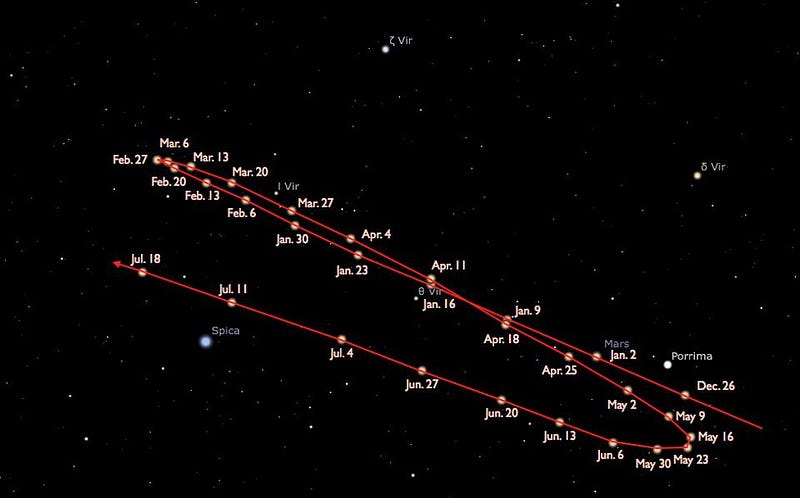
When it was first put forth nearly 500 years ago, the Copernican model of the Solar System presented a fascinating alternative to the mainstream explanation. One of the classical pieces of evidence for geocentrism, or the notion that planets:
- orbited the Sun,
- in a great, off-center circle,
- with the planet’s orbit itself moving around a smaller circle that moved along the larger circle,
- creating a specific pattern for each planet, where during most of the year they would move in one specific direction relative to the background of stars, but for a short interval of time, would appear to stop, reverse course, stop again, and then resume its original motion.
This phenomenon, known as “retrograde motion” (as opposed to prograde motion), was a complex piece of evidence against circular, heliocentric orbits for quite some time. But one of the great leaps that Copernicus made — at least, as far as we can historically trace things back, as Aristarchus’s treatise no longer survives — was to demonstrate how, if inner planets orbited at higher speeds than outer planets, this periodic apparent retrograde motion could be explained without resorting to epicycles, or circles-upon-circles, at all.
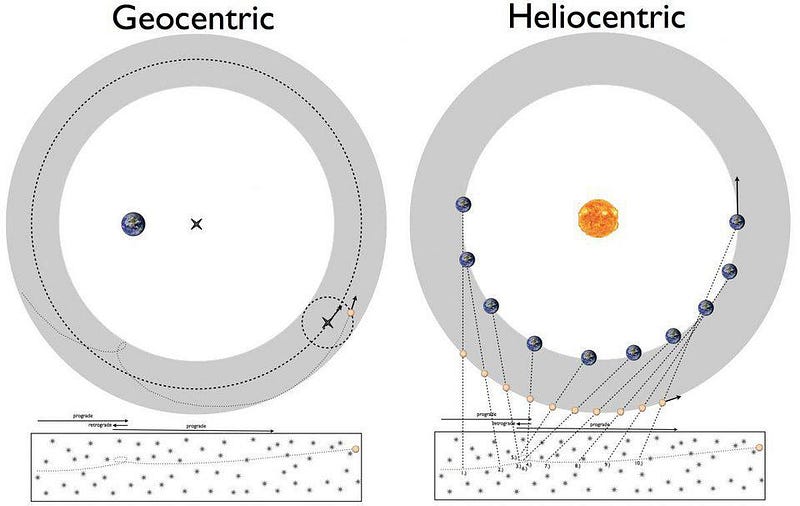
If there was no need for Earth to occupy a special position in the Universe, then perhaps it, along with everything else in the Universe, would be governed by the same physical laws. Planets orbited the Sun, moons orbited planets, and even objects that fell to Earth here on our surface might all be governed by the same universal law. While it took more than a century of development to go from Copernicus’s original idea to the discovery of the first successful law of gravitation, and more than an additional century for it to be directly tested, the heliocentric vision of Copernicus has been borne out to be quite correct.
Today, we’ve extended the Copernican Principle to be far more all-encompassing. Our planet, our Solar System, our place in the galaxy, the Milky Way’s position in the Universe, and for that matter every planet, star, and galaxy in the Universe should all be, in a sense, unremarkable. The Universe should not only be governed by the same laws and rules everywhere and at all times, but there should be nothing special or preferential about any location or direction within the entire cosmos.
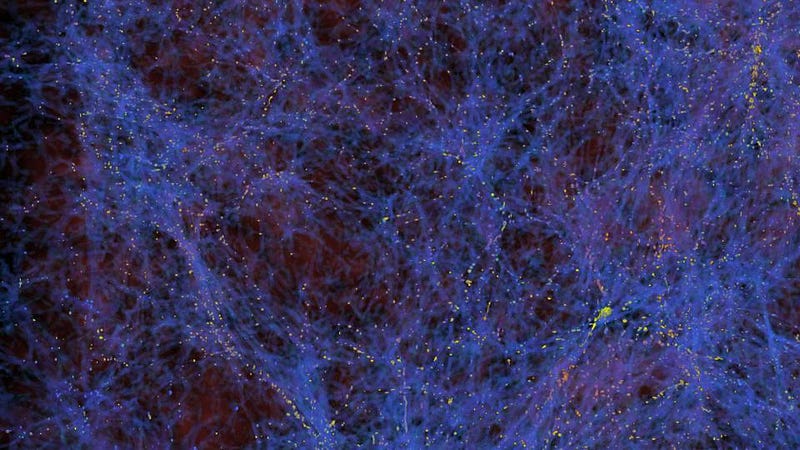
This, of course, is also an assumption. We assume that the Universe is the same in all directions — or isotropic — and that it’s the same in all locations — or homogeneous — at least on the largest cosmic scales of all. But if we want to put that assumption to the test, we have to accomplish two tasks.
- We have to quantify it. It’s one thing to assert that the Universe is isotropic and homogeneous, but it’s quite another to understand at what level is your Universe isotropic and homogeneous, and at what level do anisotropies and inhomogeneities start to matter? After all, if you were to measure the average density of the Universe, it comes out to somewhere around one proton per cubic meter; planet Earth alone is ~10³⁰ times as dense as the Universe’s average, clearly demonstrating that on small scales, the Universe isn’t homogeneous at all!
- We have to measure the Universe and check. We fully expect to find, on large cosmic scales, a Universe that’s very close to perfectly uniform: close to perfectly isotropic and close to perfectly homogeneous. However, there should be some anisotropies and inhomogeneities on all scales, and observations should reveal just how imperfect our Universe is.
Unless theory and observations match up, we’re going to have a problem, and that ought to cause us to question the validity of the Copernican Principle if there is a significant mismatch.

The Universe, as we understand it, originated not merely from a hot Big Bang, but from a state known as cosmic inflation that preceded and set up the Big Bang. During inflation, the Universe didn’t consist of matter and radiation, but rather was dominated by a form of energy inherent to the fabric of space itself. As the Universe expanded, quantum fluctuations not only occurred, but got stretched across the Universe due to the expansion. When this phase — and hence, inflation — came to an end, the energy-inherent-to-space got converted into matter, antimatter, and radiation, giving rise to the hot Big Bang.
These quantum fluctuations, during this important transition, got converted into density fluctuations: regions with slightly above-average or below-average densities. Informed by the observed fluctuations that we see in both the cosmic microwave background and the large-scale structure of the Universe, we know that these fluctuations were at about the 1-part-in-30,000 level, meaning that you might get a rare fluctuation, about 0.01% of the time, that’s about four times that magnitude. On all scales, large and small, the Universe is born almost perfectly homogeneous, but not quite.
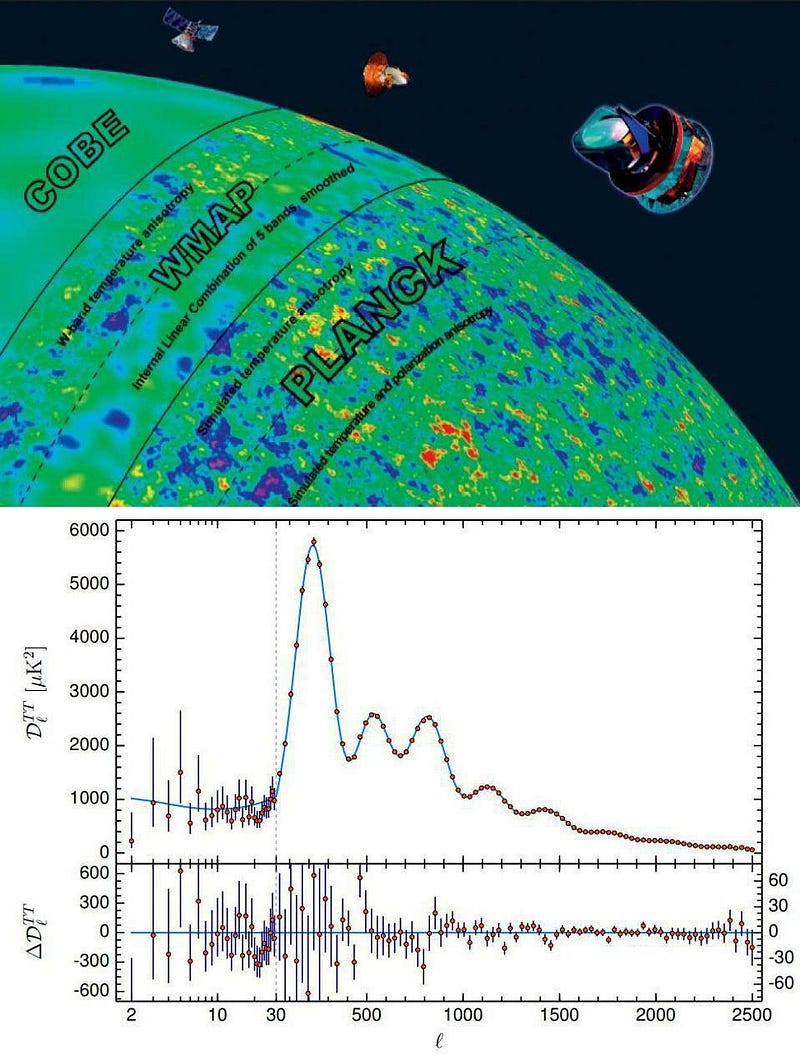
That said, if you want to form gravitationally bound structures in your Universe, and this is true regardless of what distance scale you’re looking at, you have to wait. Enough time needs to pass so that:
- these initially overdense regions, barely above the average density, can grow,
- which only happens once the cosmic horizon, or the distance light can travel from one end to another, becomes larger than the distance scale of your fluctuation,
- and they have to grow from the ~0.003% level to the ~68% level, which is the critical value to lead to gravitational collapse and rapid (i.e., nonlinear) gravitational growth,
- which only then can lead to observable signatures like quasars, galaxies, and enriched, hot gas clouds.
On average, this means that above a certain cosmic distance scale, your odds of getting coherent cosmic structures that span such a large scale are small, while below that scale, structures should be relatively commonplace. Although a full likelihood of precisely what’s likely, as well as how likely it is to occur, has not sufficiently been performed, the general expectation is that large, coherent cosmic structures should fizzle out on scales larger than 1-to-2 billion light-years.
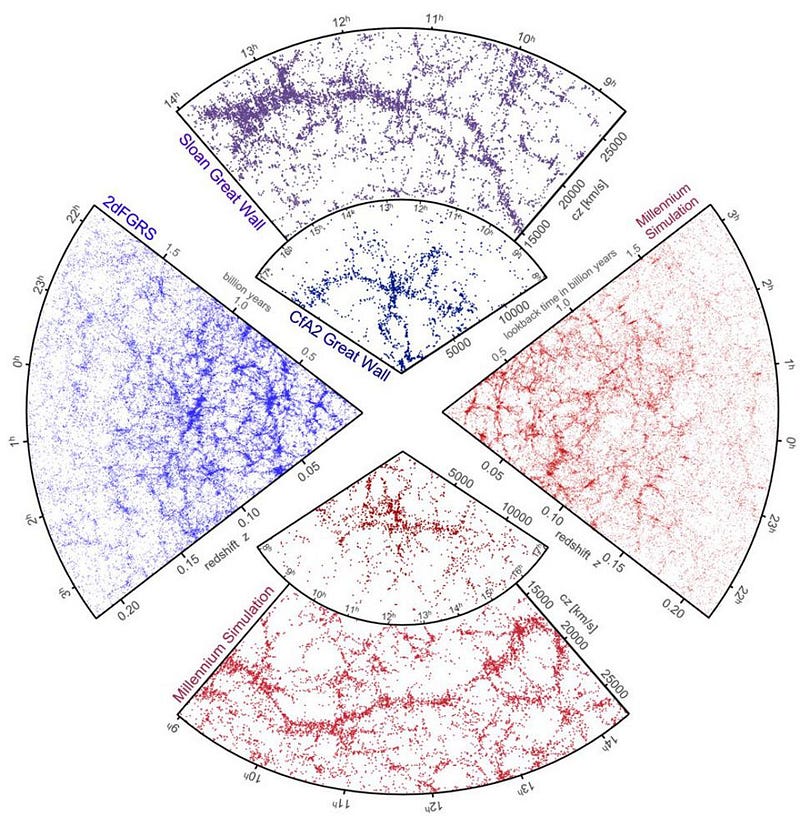
Observationally, however, this isn’t quite borne out the way we might have naively anticipated. Prior to 2010 or so, our large-scale structure surveys had revealed great “walls” in the Universe: galaxies clustered together on cosmic scales, forming coherent structures spanning hundreds of millions of light-years, up to somewhere around 1.4 billion light-years at maximum. Within the last decade, however, a few structures have been identified that appear to exceed the expected limit. In particular:
- the Huge LQG (large quasar group) is a collection of 73 quasars that form an apparent structure some ~4 billion light-years long,
- the Hercules-Corona Borealis great wall is an observed clustering of around 20 gamma-ray bursts, indicating a structure spanning ~10 billion light-years in length,
- and recently, at the 238th American Astronomical Society meeting, researchers led by Alexia Lopez presented evidence for a giant arc of ionized magnesium gas found by examining the absorption properties from background quasars, with the inferred structure spanning 3.3 billion light-years across.
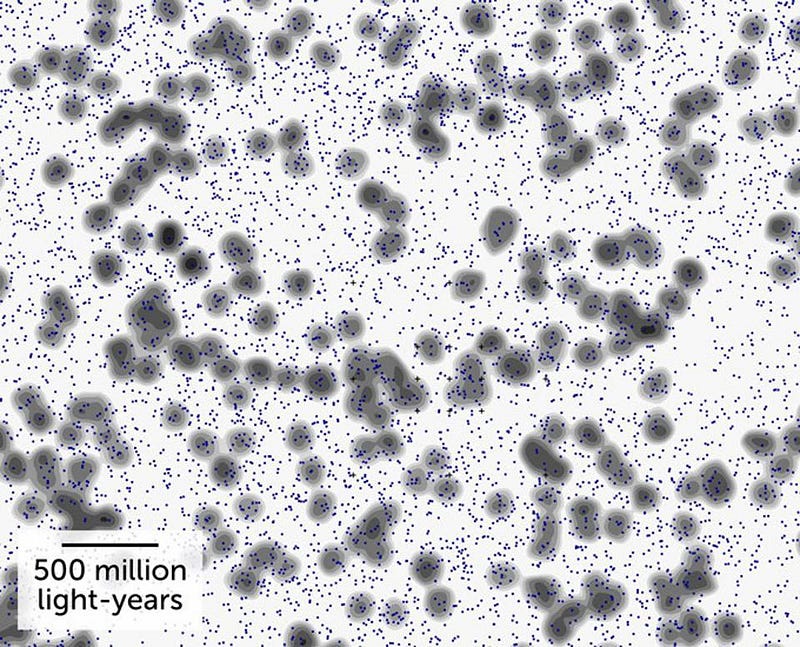
It might seem, at face value, that these structures are huge: too huge, in fact, to be consistent with the Universe as we know it. But we have to be very, very careful with claiming that we live in a Universe that violates large-scale homogeneity, particularly when we have so much other evidence supporting it. In a landmark paper, cosmologist Sesh Nadathur put forth two interesting considerations when examining these structures in detail.
- If you simulate “artificial data” that definitely has no structures on cosmic scales above a certain distance, your structure-finding algorithm can still fool you into thinking you’ve found a structure, even though it’s just an artefact of how insufficient your search algorithm is.
- Evidence of these large-scale features is not automatic evidence that the standard cosmological model is false; you have to quantitatively ask whether the prevalence of these large structures is incompatible with predictions, such as by measuring the fractal dimension of the Universe and comparing it with the predictions of our dark energy-and-dark matter-rich Universe. This has not been performed by any of the groups making the observational claims that these structures violate large-scale homogeneity.

While the first issue has been addressed by recent papers in the field, the second issue has never been sufficiently addressed. One way to think about this is to imagine you’ve got a box full of a very large number of matchsticks, and you drop them all on the floor and let them scatter where they may. The pattern you get will have an element of randomness, but it won’t be totally random. Instead, you’d get a particular clustering pattern.
You’d see many isolated matchsticks, along with some that looked like they aligned 2, 3, 4, or even 5 in a row. However, there would be some clustering patterns, like 8-to-10 matchsticks all in a row, that you’d never anticipate seeing.
However, what would happen if you had one group of 4-to-5 matchsticks in a row that was somewhat near another group of 4-to-5 in a row. There would be a risk that you’d incorrectly conclude you’d discovered an 8-to-10 matchstick structure, particularly if your “matchstick finding-and-correlating” tools weren’t perfect. Even though we now have numerous examples of these larger-than-expected structures, none of them above about 1.4 billion light-years have been determined to be unambiguously real.
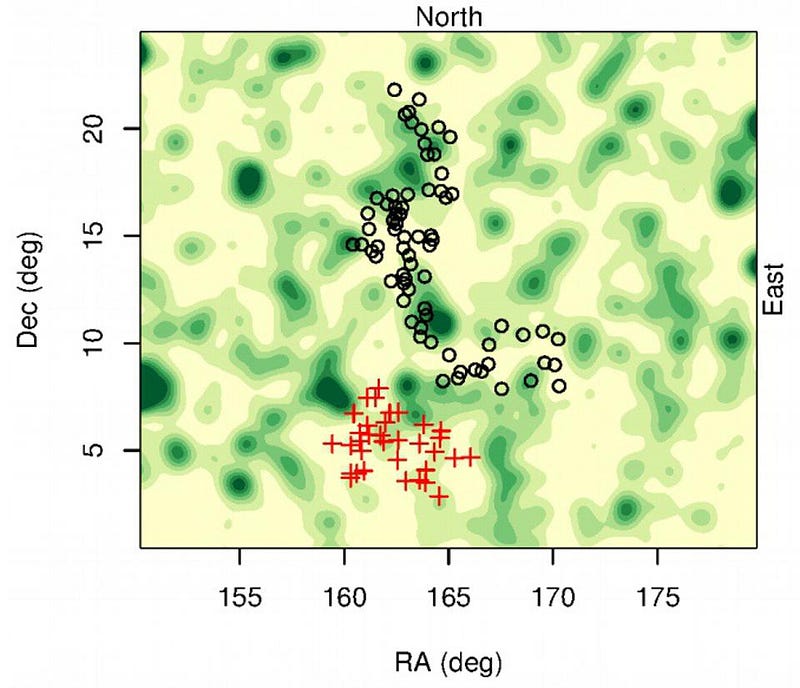
There are some important points, when considering whether the Universe is truly homogeneous on the largest of cosmic scales, that most people — even most astronomers — often overlook. One is that the data is still very poor; we have not even identified most of the underlying galaxies supposedly behind these quasar, gas cloud, and gamma-ray burst features. When we restrict ourselves to high-quality galaxy surveys, there are no structures larger than ~1.4 billion light-years.
Secondly, the Universe itself is not born perfectly homogeneous, but with imperfections on all scales. A few large, uncommon, but not excessively rare fluctuations could provide a very simple explanation for why we see structures on larger cosmic scales than a naive analysis would predict.
These larger-than-expected structures, if they turn out to be real, would pose quite a conundrum not just for the assumption of homogeneity, but for the foundations of modern cosmology and the very essence of the Copernican Principle. Still, there are some substantial hurdles that must be cleared before the evidence becomes conclusive, rather than merely suggestive. It’s a fascinating research topic to keep your eye on, but just like you shouldn’t bet on a preliminary result that suggests Einstein is wrong, you shouldn’t be so fast to bet against Copernicus, either.
Starts With A Bang is written by Ethan Siegel, Ph.D., author of Beyond The Galaxy, and Treknology: The Science of Star Trek from Tricorders to Warp Drive.





